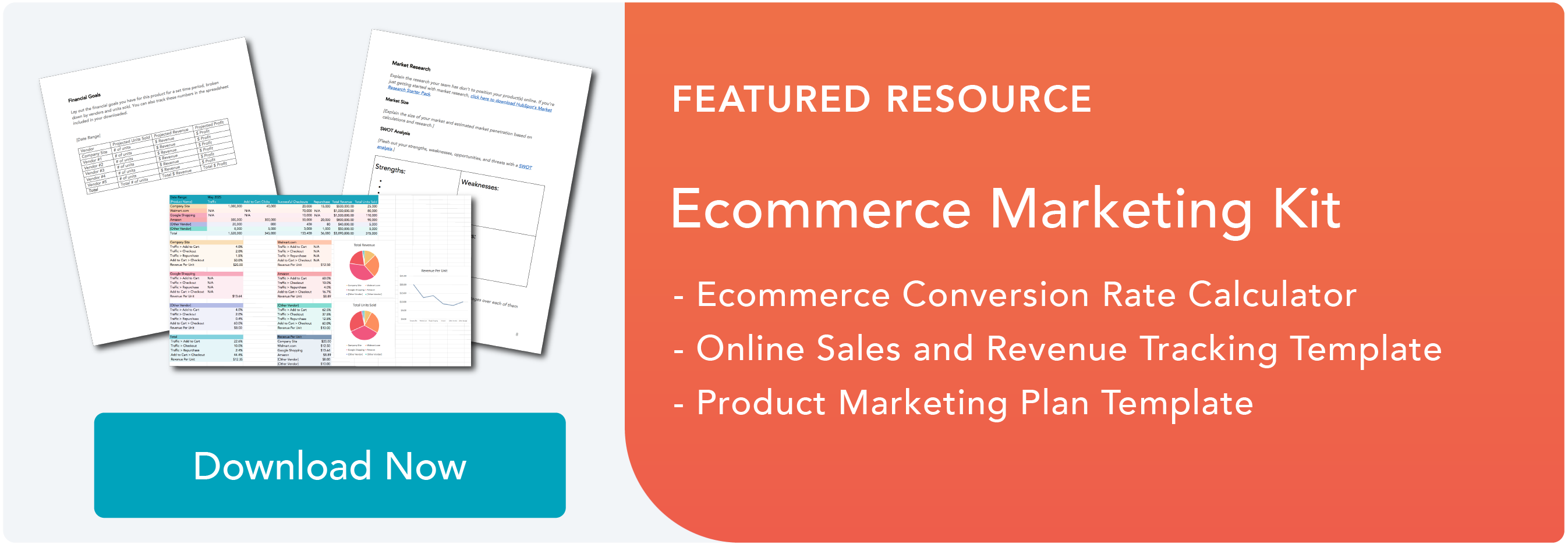Ecommerce sales accounted for 21% of all retail sales worldwide in 2022 — and this figure is predicted to reach 24.5% by 2025.As ecommerce sales continue to rise, you may want to start your own online store. Thanks to the availability of ecommerce website builders and other website building platforms, creating one has never been easier. But choosing a platform is just one step of the process.

In this post, we’ll walk through how to start an online store step-by-step. Then we’ll break down the costs of starting one, so you know how much money you’ll need to invest. Let’s get started.

How to Start an Online Store
- Select your ecommerce niche.
- Purchase a domain.
- Choose your platform.
- Pick a theme and customize it.
- Add products.
- Create a checkout funnel.
- Create key pages.
- Add a blog.
- Install add-ons.
Step 1: Select your ecommerce niche.
Before you start an online store, you need to decide what you’re selling and who you’re selling to. In other words, you need to identify your ecommerce niche.
Ecommerce expert Steve Chou considers choosing a niche as “probably the most important step in the whole process.”
 Having a niche will require you to narrow down what you sell to either one type of product or a single category of products.
Having a niche will require you to narrow down what you sell to either one type of product or a single category of products.
This, in turn, will help reduce your marketing and advertising costs, limit your competition, and inspire brand loyalty more easily, among other benefits.
The best ecommerce niches target a highly specific buyer and represent an untapped market — meaning market demand has not been met by existing products or brands.
Technology, home office equipment, entertainment, and home gym and fitness gear are some of the most lucrative ecommerce niches in recent years.
You can identify fast-rising ecommerce niches by using online tools like Google Shopping Insights.

This tool will identify increasingly popular retail categories in Google Search, their growing locations, and the associated queries.
Step 2: Purchase a domain.

The next step after choosing your niche is to purchase and register a domain name.
There are hundreds of domain registrars for you to choose from. Domain.com, Namecheap, HostGator, and Bluehost are some of the cheapest and most secure options.
Before making your purchase, you want to choose a name that’s short, unique, and easy to memorize and spell. It should also hint at what your store sells.
Jungalow, for example, is a home decor company that aims to help customers make their homes more colorful, patternful, and “jungalicious.” That’s why its domain name aptly combines the words “jungle” and “bungalow.”
Once you’ve decided on a name, it’s easy to register it. Just visit a domain registrar, search your desired name, select your term of registration, and enter your payment info.
To thoroughly walk through the domain registration process, check out Everything You Need to Know about Custom Domains.
Step 3: Choose your platform.

Many platforms can help you start an online store without building it from scratch. Two of the most popular options are Shopify and WooCommerce.
Comparing Shopify vs. WooCommerce, you’ll see they offer two very different approaches to building and managing an online store.
Shopify is a hosted ecommerce solution, which means you’ll purchase a plan that offers hosting and ecommerce tools and features for a monthly fee.
WooCommerce, on the other hand, is a free plugin you can add to your WordPress site to quickly set up an online store. However, while the WooCommerce plugin is free to download, it does require you to purchase web hosting separately. You’ll also have to take on more responsibility for your online store's performance, security, and day-to-day management.
Once you’ve selected a platform that meets your needs and goals (and selected a hosting provider if necessary), you can connect your domain name and start setting up your store.
Step 4: Pick a theme and customize it.

You’ll want to select a theme that meets your online store's needs, goals, and brand identity. In addition to being able to display merchandise, you’ll also want a theme that:
- Provides an excellent user experience for mobile customers.
- Offers pre-designed templates that are specific to ecommerce.
- Offers customization options for every page on your site, especially product pages.
- Makes product searching easier for the audience.
- Makes navigating easier with organized categories and a search box.
Once installed or activated, you can begin customizing your theme to reflect your brand's unique look and feel. That might entail changing the logo, color scheme, images, header, footer, navigation menu, and any other feature you wish.
Step 5: Add products.

It’s time to add merchandise to your site. First, you’ll add each product individually, providing a title, description, image, and category for each. Categorizing your products will enable your customers to sort and browse them more easily.
You’ll also have to provide additional information like pricing, inventory, and shipping for each product. CTA buttons like “Purchase” or “Add to Cart,”customer reviews and testimonials, and a display of related products are other features you can add to your product pages to help convince customers to make a purchase or to upsell additional products.
When writing product pages, experienced retail tech and writer Kaleigh Moore recommends that you “add specs and details, use storytelling/signature brand voice, and incorporate testimonials.”
Once you’ve added all the necessary information for a product page, you can publish it and repeat the process for the rest of your inventory.
Step 6: Create a checkout funnel.

Next, you need to set up a way for people to buy products from your online store. This is known as a “checkout funnel” and includes three major steps: a shopping cart, checkout page, and confirmation page.
- Shopping cart: This is where customers can put products they want to buy, look at the total cost of all these items, and move forward with the checkout process.
- Checkout page: This is where the customer will find all their payment options and shipping and delivery information and be able to place their order.
- Confirmation page: This is where customers will see confirmation that their order was placed and processed successfully.
To set up this funnel, you will have to configure general settings in your dashboard to enable coupons, taxes, shipping locations, currency options, and more.
Step 7: Create key pages.
We’ve already discussed some essential pages for an online store, including product pages and the cart, checkout, and confirmation pages. After you’ve created these, you’re not done quite yet. Online stores would benefit from having some (or all) of the following pages as well:
- About
- Shipping
- Returns and Exchanges
- FAQ
- Contact
Take KinkyCurlyYaki, for example, which has an Our Story, FAQ, Shipping & Processing, Exchanges & Returns, and Contact page.

These pages provide essential information that prospective and existing customers are looking for, like the company’s mission, shipping and return policy, contact information, and answers to their customers’ most frequently asked questions. These pages are key to gaining consumer trust and confidence.
Here’s a video to show you more ways to attract people to your ecommerce store.
Step 8: Add a blog.
Adding a blog to your ecommerce website can help you attract visitors, turn them into leads, and boost your visibility on SERPs.
For example, frank body is a skincare company that has a blog on its site where it writes content about body positivity, hygiene, sensitive skin, and much more.

Some visitors might find frank body by searching for these topics and landing on the blog. If they like what they read, then they'll be more likely to look at the products and make a purchase.
Regularly creating content that solves challenges of your target audience, like frank body, will help you attract visitors and make your business appear credible and trustworthy, which boosts the chances of those visitors becoming leads.
In addition to helping you generate leads, blogging can help improve your ecommerce site’s SEO.
Blogging will help you grow the number of indexed pages on your site. Since search engines consider sites with more indexed pages more established than sites with fewer indexed pages, blogging can help improve your rankings on SERPs and drive sustained organic traffic to your online store.
6 Ways to Increase Your E-commerce Conversion Rate (Optimization)
Step 9: Install add-ons.

At this point, you could push your site live or install some add-ons to extend the functionality of your site. The beauty of using flexible platforms like Shopify and WooCommerce is that you can install extensions immediately or wait until a need arises.
Maybe you’ve increased your inventory and want to add an image or video gallery to your homepage to showcase your new products. Maybe you want to integrate with a CRM to manage your customers and their orders better. These are just a few examples of ways you might enhance the functionality of your store with add-ons.
How much does it cost to start an online store?
On average, starting an online store costs between $94 and $1,375 per year.
Like the cost of building a website, the cost of starting an online store depends on a range of factors, including what hosting service you choose, what templates and extensions you add, and more.
Below we’ll limit our focus to the basic requirements of starting an online store. At the bare minimum, you will need a domain name, hosting, and inventory. Here’s a quick breakdown of those costs.
Domain name
Average cost: $10 - 15 per year
Generally, registering and renewing a domain name costs around $10-15 per year. However, the price can vary depending on a range of factors, including:
- The domain registrar you choose, the available domain names, privacy, reputation, and expiration fees they offer.
- The domain extension you want and how popular it is
- Whether your domain privacy and protection are included in the domain name price or if it’s an additional cost
- The term of registration you select
Web Hosting
Average cost: $7 - 30 per month
Web hosting costs vary depending on whether you use proprietary or open-source software.
If you opt for proprietary software like Shopify, then you’ll select a premium plan that includes web hosting as well as other features and tools to help you secure, update, and maintain your store. Shopify offers three plans, which cost $29, $79, and $299 per month, respectively. The basic plan at $29 per month is perfect for new online businesses.
If you use open-source software like WordPress with the WooCommerce plugin, both the software and plugin will be free to download and install. But you’ll have to purchase web hosting from a third-party provider.
Ecommerce hosting tends to be more expensive than hosting for non-ecommerce websites, but not always. SiteGround, for example, offers WordPress and WooCommerce hosting plans for the same rates at $6.99, $9.99, and $14.99 per month, respectively. WPEngine, on the other hand, offers web hosting plans starting at $25 per month and ecommerce hosting plans starting at $30 per month.
Inventory
Average cost: $0 - $1000
The cost of buying inventory can vary drastically, depending on how and what you sell. You have two ways of selling products: dropshipping or selling wholesale products.
If you’d like to avoid inventory costs, then opt for dropshipping. With this business model, you don’t store, pack, and ship your own inventory.
Instead, when a customer purchases an item from your online store, you forward the order to your supplier, and they ship it directly to the customer.
There are no upfront costs with dropshipping, but most suppliers will charge a fee for processing and shipping an order. That means your profit margins will be smaller.
If you’d like a more traditional approach, then you can start an online store with your own inventory. However, that means you’ll have to purchase inventory to start your online store.
This cost can range from hundreds to thousands of dollars, depending on what items you’re purchasing and the minimum order quantity your vendor requires. On average, purchasing wholesale products locally costs about $100 per order. However, on average, purchasing wholesale products from other countries costs closer to $1000 per order.
Starting Your Own Online Store
Offering more control and convenience for buyers and sellers alike, ecommerce is continuing to grow and make up a larger percentage of retail sales across the world. If you have a great idea that you’d like to monetize, then you can start your own online store.
Starting one has never been easier, thanks to platforms like WordPress and WordPress alternatives like Shopify. With less than $100, you can create an ecommerce website and begin attracting customers and generating sales.
Editor's note: This post was originally published in March 2011 and has been updated for comprehensiveness.










